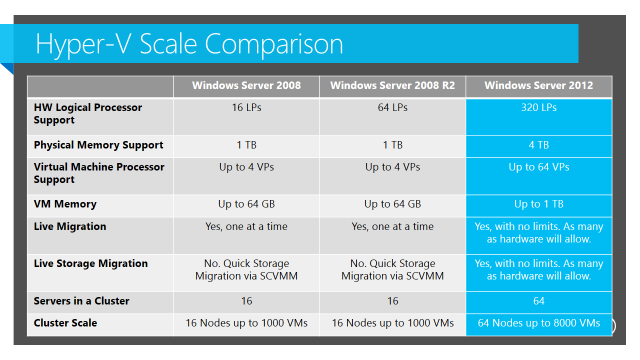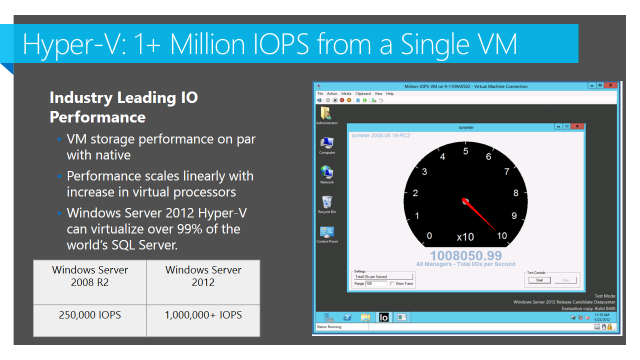Cloud Broiler: Hyper-V: A Platform that Scales out for Building the Largest Public and Private Clouds
Hyper-V 3.0 in many ways is the crown jewel of our enterprise virtualization and private cloud strategy and is the heart of where many of the improvements in our flagship Server OS reside. So we should probably talk about what has improved since our previous Hyper-V releases, and what you can do with our hypervisor technology out of the box in Windows Server 2012 today.
The feature chart above paints an amazing picture here. When I was first exposed to Hyper-V, it was as a beta offering as part of a Service Pack in Windows Server 2008. For a free and beta quality offering, and as a skeptic coming out of the Open Source and VMware community working at IBM at the time, it was good, but I didn’t seriously think it would present a huge challenge to the competition.
My, how time has passed, and how much Hyper-V has grown in those five years.
Today, in Windows Server 2012, Hyper-V has matured into not just a solution that is at parity with our competition’s hypervisors, but vastly exceeds them in many areas. We now support up to 320 logical processors on a single virtualization host, if you can find a box that big to run it on! We also support up to 4 Terabytes of main memory per system.
Each VM can be assigned up to 1 Terabyte of dynamic memory as well as up to 64 virtual processors per VM – which includes Linux VMs as well. I don’t think we’ve done a particularly good job of talking about how well Linux scales and performs on our hypervisor, and in the coming weeks, I’m going to get a bit more into that as well.
You can have up to 64 Hyper-V servers in a single cluster, which supports up to 8000 VMs.
And that’s just raw compute scalability. In Windows Server 2012, we’ve also introduced a new virtual machine storage format called VHDX that enables you to have up to 64 Terabytes per virtual disk.
These are some pretty amazing numbers here, and I have been fortunate enough to work with partners who are building some of the largest private cloud offerings using this very same technology. And it should also go without saying that these same very improvements in Hyper-V allow Microsoft to scale out its own Public Cloud infrastructure with Windows Azure.
It’s been five years since we’ve introduced Hyper-V, and in every area that counts in terms of raw scalability, we exceed by a considerable margin what our competitor’s x86 hypervisor technology is capable of doing. We can run the largest VMs for mission critical workloads. We have the largest VM disks for the most demanding storage requirements. We support the largest cluster sizes for scale-out infrastructure, and we also have the deepest integration with hardware features supported by our vendor partners in order to extract the highest performance out of that equipment as possible – more of which I will delve into in future posts.
I also want to re-iterate that everything you see here you get out of the box in Windows Server 2012 – we don’t charge you extra for this. And in fact, if you use our Hyper-V Server product, you get all of this for free.
No, seriously, it’s free.
Hyper-V: It’s not just about the numbers
Clearly, we think Hyper-V is a very big deal and everyone who works with it is extremely proud of the Server team that put so much hard work into it. But these big scalability numbers are meaningless unless the software does exactly what our customers want it to do.
First, we believe that Hyper-V needs to handle the most important mission-critical workloads of your enterprise, and that we want you to be able to virtualize everything. What do we mean by everything? We mean that there shouldn’t be a single workload at your enterprise that is considered non-virtualizable, regardless of the performance characteristics of the applications running on it.
Internally, at Microsoft, we’re big on dogfooding, so Hyper-V runs all of our important systems, be it our messaging infrastructure, our application servers and our databases. To get a bare-metal box provisioned from our internal IT rather than a new virtual server takes an act of Congress, basically.
So we want you to throw your biggest, baddest, nastiest workloads at Hyper-V. That’s why we’ve enhanced our hypervisor to the extent that it will be almost impossible for the typical enterprise to exceed its capabilities on pure hardware scalability concerns alone.
We’ve proven, for example, that we can achieve 1 million IOPS with virtualized instances of SQL Server – that’s four times faster than what was capable with Hyper-V in Windows Server 2008 R2. Seriously, if you have a single business intelligence app or a highly transactional database that needs more than a million IOPS then we really want to hear from you.
It’s also important to stress that we believe that a hypervisor’s performance must increase in a linear fashion as you add processor cores, in order to maximize your investment in server hardware. We know that these big server boxes in your datacenters are expensive and represent a significant cost to your organization’s IT. Nothing should be wasted.
The other thing that I would really like to stress is that Hyper-V 3.0 should really be in top consideration in your organization as your main hypervisor platform particularly if you have a lot of Microsoft workloads.
Whether it is Dynamics, Exchange, SharePoint, Lync or SQL Server, you can be assured that our engineering and software product teams have worked very closely to ensure that everything is tightly integrated and performs optimally when virtualized. We deeply understand the performance characteristics of our own workloads and know how to keep our hypervisor busy.
I mean, we make all these software products, right? Why wouldn’t we want to make sure our products perform best on our own hypervisor?
This is just a tip of the iceberg of the many performance and scalability enhancements you’ll find in Windows Server 2012. If you’d like to dive deeper into any of the things I have mentioned, be sure to click on the links we’ve provided below.
About the Author: Jason Perlow is a Technology Solution Professional with Microsoft Partner Hosting & Cloud Services based in the Miami-Fort Lauderdale area. He can be reached at jasonpe@microsoft.com. Read more about the Cloud Broiler blog series here.

